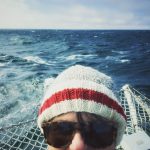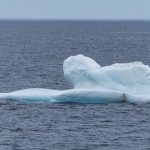
Standing in the midst of the hipster hiking adventure store, I felt like a total fraud. Not exactly adverse to shopping – as friends will attest – purchasing serious rainproof gear was novel for me. But it was necessary as I was prepping to depart on an Arctic adventure with the Royal Canadian Navy as part of the ‘Canadian Leaders at Sea’ (CLaS) program.
I am not by nature a thrill-seeker. I have huge respect for my friends who train for marathons or hike the Camino de Santiago but my idea of adventure runs more to wearing Fluevog shoes. Yet I found myself in August 2019 signed up to sail from Iqaluit on Baffin Island (known in Inuktitut as ᕿᑭᖅᑖᓗᒃ/Qikiqtaalukto) to St John’s, Newfoundland aboard Canadian frigate HMCS Ville de Québec. My shipmates for the five days would include 200+ sailors and officers plus 14 fellow ClaSmates who had been selected for this innovative experiential learning program.
I agreed to apply for the course following generous encouragement from a respected mentor who had participated in an earlier version of the program. She had returned with such enthusiasm and passion that I readily said yes. I was seriously second-guessing my naïve enthusiasm as I flew the 2335 km (1450 miles) due north from my home in Toronto to Iqaluit, the capital of Nunavut. Nunavut is the newest territory in Canada and one of the least populated places on earth with approximately 35,000 people inhabiting 725,000 square miles, roughly the size of Mexico. Far more Canadians have been to Mexico than Nunavut. As I sat on that flight heading north, I went through a dozen scenarios in my head: what if I was seasick? Could I do the drills? I hate guns! How would I cope with negligible privacy? Why wasn’t I going to lounge on a beach in Mexico?
From these inauspicious beginnings what unfolded was one of the best experiences of my life.
The CLaS pilot was developed to increase awareness of why and how the Navy is “ready to help, ready to lead, ready to fight.” In a nutshell it’s also about combating ‘naval blindness’ as most Canadians – especially those in cities – rarely pay much attention to the armed forces. When we do think about the Navy, in my experience, it’s usually with a Hollywood lens. Originally designed for federal political leadership, CLaS is now open to a much wider group of Canadians. In my group of fifteen we ranged in age from mid-30s to mid-70s, hailed from Victoria to Québec City, and worked in roles such as running a major media firm, management consultants, entrepreneurs and a Member of Parliament. I was the only person from the university sector. The itinerary included a mix of briefings, scheduled activities and free time to explore the ship and meet the sailors.
HMCS Ville de Québec’s motto is Don de Dieu feray valoir loosely translated as ‘I will make good use of God’s gift’. This was auspicious as thankfully from the moment I boarded the ship my apprehension started to dissipate, moving from fear to thrill. This was mostly due to the warm reception from the captain and crew. And frankly there wasn’t time to feel concerned as I was immediately swept up in the energy and rhythm of life on board a frigate. I was impressed by the variety of activity and also by the unfettered access we had to explore and engage in conversation with the sailors and officers. The crew were the best part of the experience. I met incredible people from all over Canada; all had interesting stories about how they found themselves serving in the Navy. I particularly enjoyed honest conversations with the female sailors who comprise about 15% of the crew including two officers.
 I quickly had to learn how to function onboard including figuring out how to master the ladders (no stairs!) between decks. The food was plentiful, fresh and tasty – including the delightful tradition of ‘soup at ten’ to tide you over from very early breakfasts to lunch. The scenery was stunning especially the opportunity to witness the Northern Lights and even see a polar bear dipping off an iceberg. The sleeping quarters were basic – even claustrophobic for newbies – but you quickly learn to get in and out of your ‘rack’ without disturbing others and thankfully for this insomniac I found that deep, sweet sleep comes easily with salty air and decent seas.
I quickly had to learn how to function onboard including figuring out how to master the ladders (no stairs!) between decks. The food was plentiful, fresh and tasty – including the delightful tradition of ‘soup at ten’ to tide you over from very early breakfasts to lunch. The scenery was stunning especially the opportunity to witness the Northern Lights and even see a polar bear dipping off an iceberg. The sleeping quarters were basic – even claustrophobic for newbies – but you quickly learn to get in and out of your ‘rack’ without disturbing others and thankfully for this insomniac I found that deep, sweet sleep comes easily with salty air and decent seas.
The CLaS program over five days at sea included a variety of activities to demonstrate the work of the Navy and how a ship operates; in addition to formal briefings, we learned how to handle equipment and participated in a variety of drills. I did everything from loading ammunition, observing warfare simulations in the ops room and operating fire-fighting equipment. We also had the chance for unexpected delights such as tai chi in the aircraft hangar and enjoying a ‘Sunday sundae’ on the bridge, all as we edged our way south down the rugged coast of Labrador. Apart from wildlife, we didn’t see another soul on our journey until we sailed into magnificent St John’s harbour.
What did I learn about leadership as part of Canadian Leaders at Sea? There were scant examples of heavy-handed ‘command and control’ which Hollywood had prepped me for – no bellowing orders from the bridge or Sean Connery conspiring below decks. The commanding officer of our ship was Michael Eelhart, an unassuming engineer from land-locked Alberta. He is one of the most effective leaders I have ever seen in action, hands down. Cdr Eelhart leads by example, motivating his team by modeling admirable behaviour and personifying grace under pressure. He has an extraordinary ability to balance empathy with clear expectations; a quiet gravitas which challenges all to stretch beyond our comfort zone.
 The distributive model of leadership I saw in action onboard resonated deeply with me. Every member of the crew from the bridge to the galley knew what their role was and how their individual actions contributed to the success – or in times of peril, the very survival – of the ship. For example, on day three there was a major drill which included a (fake) fire in the engine room and simulated casualties. The crew each have a designated role and muster to their station within six minutes, equipped and ready to roll. I was astonished to witness the officers’ mess convert into a surgery, complete with operating table. It was impressive.
The distributive model of leadership I saw in action onboard resonated deeply with me. Every member of the crew from the bridge to the galley knew what their role was and how their individual actions contributed to the success – or in times of peril, the very survival – of the ship. For example, on day three there was a major drill which included a (fake) fire in the engine room and simulated casualties. The crew each have a designated role and muster to their station within six minutes, equipped and ready to roll. I was astonished to witness the officers’ mess convert into a surgery, complete with operating table. It was impressive.
Understandably at the heart of the Canadian Forces leadership model is a commitment to mission success. This has great parallels for philanthropy professionals and more broadly for leaders in the nonprofit sector. Here are the ten critical requirements for a leader in the Canadian Armed Forces, all equally weighted:
- Seek and accept responsibility and accountability
- Perform under stress
- Apply skills and knowledge
- Take initiative and be decisive
- Seek and accept advice and constructive criticism
- Grow a team
- Plan effectively
- Communicate clearly
- Properly supervise subordinates
- Delegate effectively
I had the opportunity to ask Commander Eelhart about how he identifies potential and what are the most important qualities that he looks for in high potential crew. In addition to the qualities outlined above, he also talked about the importance of reliability. Solid, steady shipmates form the foundation of any team.
So back to where I started: showing up was daunting for me. Overcoming my fears by embracing the experience turned out to be an extraordinary gift. I learned a huge amount about leadership – and myself – by immersing myself in an environment outside my comfort zone. Sailors wish each other ‘fair winds and following seas’ prior to departure: the wind and the sea ensuring a smooth and safe journey. This motto is now my mantra.
Krista Slade has worked in higher education administration for nearly 30 years. She is currently building a new office – Strategic Partnerships – on behalf of the Dean of the Faculty of Arts & Science at the University of Toronto, Canada’s largest university. She previously worked in the UK with the Rhodes Scholarships and was the inaugural Executive Director of CASE in Asia-Pacific, based in Singapore. Ahoy!